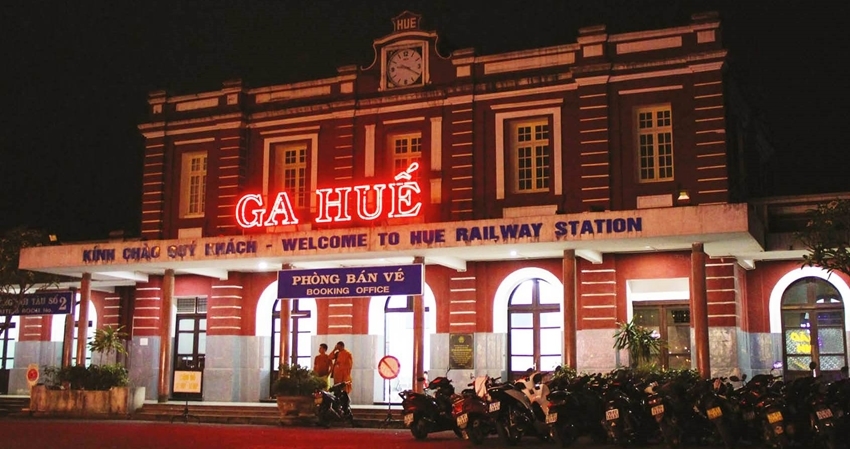 |
| Hue Railway Station - a beautiful architectural work that shimmers at night |
Not only witnessing reunions and separations, Hue Railway Station is now also a highlight on the Hue tourism map; for it has become a place to attract culture lovers and heritage enthusiasts, especially those who love buildings bearing the features of French architecture.
“I have stopped at many railway stations in Vietnam, and Hue Station is one of the works that impressed me. Not only is it located right in the heart of the heritage urban area, but also retains ancient architecture, which not every city can preserve,” praised Mr. Nguyen Hoai An, a tourist from Da Nang.
Not only impressed with this work in terms of architecture, An said that this place was also a tourist destination attracting tourists at night, especially young tourists. Indeed, the architecture of Hue Railway Station seems to exude a luxurious yet warm look at night. Many people are impressed and fascinated by this work, so they often come here to contemplate and take photos.
According to the journal “100 years of Hue Railway Station”, during nearly a century of colonial occupation of Indochina (1862 - 1954), one of the works that bears the boldest “mark of French technical architecture” is the “Indochina railway system, and the railway system penetrating China”.
Particularly, the 171km long Dong Ha - Da Nang section within the Hanoi - Saigon railway line was carefully researched and surveyed from 1899 to March 1902, started and completed in December 1908. The construction of this section was divided into two stages: the construction of the first stage started in March 1902, taking Da Nang as the starting point, gradually moving to Hue, and the construction of the second stage took Hue as the starting point, then gradually moving to Dong Ha. In November 1906, the installation of 103km of railway connecting Da Nang with Hue was completed and in December 1908, the 68km long railway connecting Hue and Dong Ha was completed. The average cost of 1km was 161,000 francs.
Along with the construction of the railway, stations were also built to ensure the operation of passenger and goods transportation, as well as train operations. The entire Da Nang - Hue - Dong Ha route, excluding the 2 terminal stations (Da Nang and Dong Ha), had 24 stops, including 1 main station, which was Hue Railway Station, 15 secondary stations and 8 stops. Once any section of railway was completed, it was put into operation. On December 15th, 1906, the Da Nang - Hue railway officially opened for operation.
According to the researcher Phan Thuan An, the area of Hue Railway Station today was originally that of Truong Sung in the past. According to Léopold Cadiere in his research on places in Hue Citadel, Truong Sung existed in the 8th century under the reign of Nguyen lords. At that time, there were also elephant stables of the royal court nearby, called the Tau Voi or Tau Tuong.
In the early years of the twentieth century, under French colonial rule, Hue Railway Station was established to connect the railway line to the South and to the North. Hue Railway Station was completed at the end of 1906. In early 1907, the Hue - Da Nang train line began operating. Then in 1908, the train line connecting Hue Railway Station with Quang Tri Railway Station also officially opened. And to provide train travelers with short stay accommodation in Hue, people also built a hotel right in front of the station called Railway Hotel (Hotel de la gare) at that time.
Although the station has also been upgraded and expanded, its architectural style has not changed much compared to a century ago. In the early decades of the twentieth century, trains (powered by coal) were a modern and convenient means of transportation. In addition, this was also a very interesting vehicle for long-distance travel. The tourist route from Da Nang to Hue was established quite early, several years after the railway was completed. At that time, there were two trains from Da Nang to Hue a day, and tourists could choose at their discretion. The morning trip departs at 6:10 a.m. The afternoon trip departs at 1:08 a.m. on winter days and at 2:30 p.m. on summer days.
It was Emperor Khai Dinh and his entourage who took the train from Hue Railway Station to Da Nang to board a ship to France in 1922. Ten years later (1932), Emperor Bao Dai also boarded the train from Da Nang to Hue Railway Station on his way back from France.
Also according to the researcher Phan Thuan An, Hue Railway Station is one of the oldest in Vietnam. It will be good if the original appearance of Hue Railway Station can be preserved since this station also has architectural and historical values.